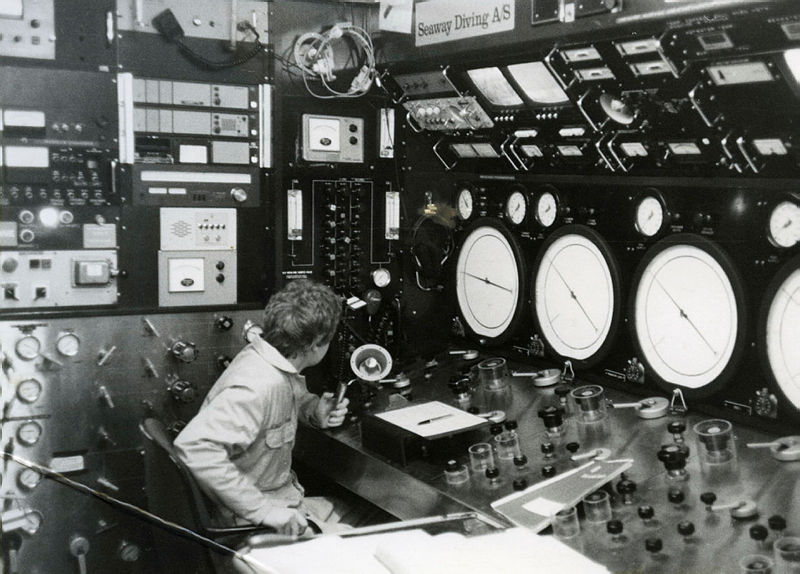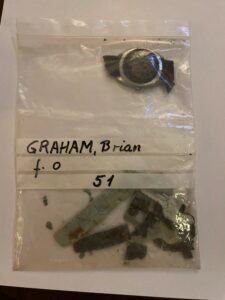Cleanup and search for the deceased at the Ekofisk field

Five diving vessels were involved in the cleanup and search for the deceased at the Ekofisk field.[REMOVE]Fotnote: https://media.digitalarkivet.no/view/90966/234. The work commenced immediately after the accident on March 27th, 1980, and continued until mid-May the same year.
The work commenced immediately after the accident on March 27th, 1980, and continued until mid-May the same year. The first deceased was found the day after the accident and retrieved by divers on the Seaway Falcon. At that time, a crushed lifeboat and remnants of the crane boom were also found. The following day, divers discovered many personal belongings and another one of the deceased. In the ensuing days, more were discovered. Altogether, 44 bodies were recovered from the North Sea at the Ekofisk field.
This was demanding work that most divers had neither training nor experience with:
There’s 70 meters of water above you, and it’s pitch-black. We shone our lights around. Many of the survival suits were scattered on the seabed. They were orange and had those yellow hoods meant to reflect. They stood out. When we found survival suits, we didn’t know if there was anything inside or not. It was a tense situation. I swam from behind and felt the hood with my hand, squeezed it. I never went and shone directly into the hood. That could be a bit overwhelming. Sometimes, you could see there was no one inside; some were filled with water. If the hood was hard, the suspense was over. You weren’t surprised when you saw a face. (Per Arne Jakobsen, diver, Seaway Falcon)[REMOVE]Fotnote: Tungland, E. M. et al. (2020) Kielland. Based on the accounts of those who were there. The Kielland Network.
The deceased were registered with an ID number corresponding to the order in which they were found. March 31st, 1980, was the day when the highest number of deceased were recovered. On that day, the Seaway Eagle and Seaway Falcon retrieved a total of 13 bodies.
Some of the divers received a shot of alcohol into the diving bell for each body they retrieved. On that day, there were so many that they ended up getting an entire bottle into the diving chamber.
Diving vessels and ID numbers of the deceased were found between March 27th and May 12th, 1980.
| DATE/SHIP | SEAWAY EAGLE | SEAWAY FALCON | SEAWAY HAWK | WILDRAKE | SS PHILLIPS | BODIES FOUND |
| 28.03 | 39 | 1 | ||||
| 29.03 | 40 | 1 | ||||
| 30.03 | 41,42 | 2 | ||||
| 31.03 | 44,48,49,50 | 43,45,46,47,51, 52,53,54,55 |
13 | |||
| 01.04 | 56,57,60,62,63 | 58,59,61 | 8 | |||
| 02.04 | 66,67,68,69,70 | 64,65 | 7 | |||
| 03.04 | 72 | 71,73,74 | 75 | 5 | ||
| 04.04 | 76,77 | 78 | 3 | |||
| 05.04 | 80 | 79 | 2 | |||
| 06.04 | 81 | 1 | ||||
| 12.04 | 82 | 1 | ||||
| BODIES FOUND |
44 |

Picture above: Everyone who was found was given an ID number, which was also written on the bag containing belongings given to the relatives. From number 51, we see that Brian Graham was one of those found by divers on the Seaway Falcon on March 31, 1980.
Read more about the cleanup work and search for the deceased.
The entire report from Phillips Petroleum after the cleanup can be read here: Digitalarkivet
Read more about this here: Complaints about drilling during the search for the deceased. – Alexander L. Kielland
arrow_backSurvived the Alexander L. Kielland disaster – Tony SylvesterSurviving the Kielland accident – Svendsbøearrow_forward